Willy Stolarczyk, piano and composition
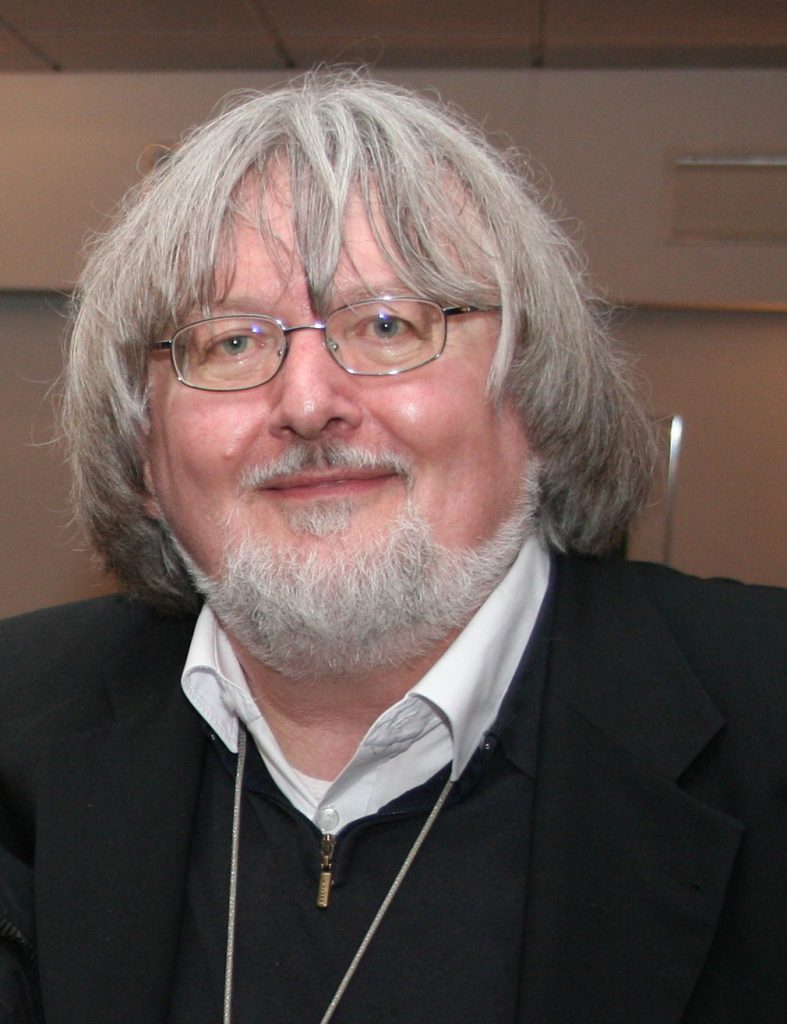
Interview: Leif Martinussen
Text and edition: Nete Parkov
In 1997, pianist and composer Willy Stolarczyk, together with his wife, flutist Lise Stolarczyk, had been a trip to Germany. On their way home, the couple had to stop at the border and show their passports, as you should at that time. The pass checker stared at Willy’s passport for a long time and then asked:
Weren’t you the one with the 96 pianos at Koldinghus?
Yes, Willy replied, so, don’t you allow me to enter the country?
Well yes, the costums officer answered a little hesitant, just do not do it again!
What the honorable official pointed to was Denmark’s biggest piano event at Koldinghus on May 2, 1996, where a symphony for 96 grand pianos, pianos and percussion on the subject “The 4 Elements” was performed – from all the slots of the ancient castle ruins – an event that, with one of the contributing pianists words, became “an unforgettable memory – and a miraculous success for Stolarczyk, obviously so familiar with” The 4 Elements “that at least he can walk on the water …”

We will return to this spectacular project later in this article, but first we need to look a little closer to the personality who did not reject the wild and amazing idea, but instead grabbed it, convinced the approving bodies and made the vision reality.
When Willy Stolarczyk in 2011 retired from his 20-year job in Vejle Municipality, it was his wish to concentrate on life as a free composer and concert pianist. He had already turned down the administrative parts of his head of culture position in a new recruitment as a “music life developer” – a title he himself defined when, after 10 years, he wanted to have more time to compose and give concerts.
In connection with his retirement, the municipality published a celebration book for him. The idea was, according to the preface, to “engrave a runic letter” for this “cultural dynamo” – who had since the mid-60’s put his colorful touch on Jutland music life, at first in Aarhus and Holstebro and since 1991 in Vejle and Triangle area.
The celebration writing is a tribute, which brings messages from friends, colleagues and collaborators over time, and it goes on with words like initiative, diligence, insight, knowledge – as well as – iron will, commitment, creativity, imagination, firefighter, and not least – baroque humor, hedonism and jollity. And then there are the loving nicknames like cultural lighthouse, cultural equilibrist, octopus, cultural partisan and even cultural shock (in the encounter with Willy’s unusual personality).
About the “cultural shock” a former student who, as an adult, became a pianist and musical teacher, tells that Willy in chamber music education placed a candy bag in front of himself as a “carrot” for the students – but, she says, “the point was that he himself took a piece of candy each time we played an error … I probably would not repeat the method with my own students, but he incorporated us quite effectively that we had to worry about it, it was life or death – or at least candy or no candy! No compromise, nothing with “almost”.
However, Willy Stolarczyk is primarily musician with a great M – as well performing as creative.
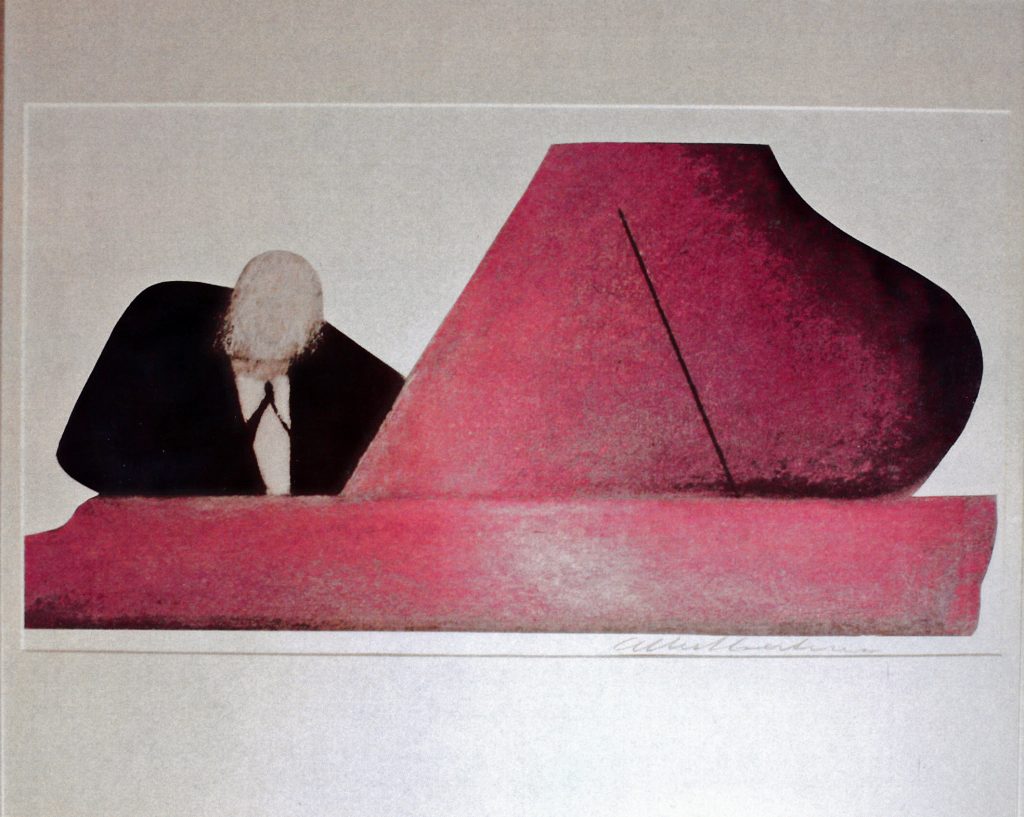
His qualities as a pianist are spelled out in this section of a review in Politiken:
“Willy Stolarczyk had not played many moves before you became convinced that here was a man who mastered his subject – which the evening’s further course could only confirm. Actually, there was no objection to come along. He has an enviable surety technique, and has almost an overview of a conductor in relation to the musical course, a superiority that allowed him to almost objectively listen to himself.” Politiken
Here he plays the first part of Haydn’s “Sonate in G-Hob. XVI:27: Allegro con brio
In the composer role, the Faroese composer Pauli in Sandageri has described him as “a party-inspired fireworks master”, and his production is in itself is indeed a fireworks of musical works, for the adult serious listeners as well as for children with every possible – and “impossible” might anyone add – crews and setups. What especially characterizes Willy as an artist and as human being is exactly just making the impossible possible, to make dream and vision come true with an at times almost supernatural willpower.
Listen to 1st part: “Introduzione” from Willy’s Café Central, written to and played by pianist José Ribera:
Has the key to succeeding in this highly ambitious plan been latent in Willy’s personality right from the start?
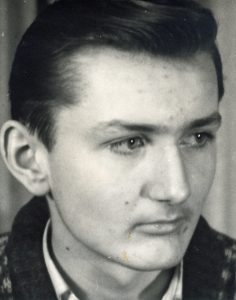
Willy was born in Nykøbing Falster in 1945, 17 days after Denmark’s liberation. He was a talented piano pupil at the city’s largest music school, driven by an uncle, and he became familiar with a large audience already from the age of 9-10 when the year’s student concerts in the big theater hall at “Industrihotellet” was settled. Classical music sounded in the music school as well as in his home, and piano and other instruments were played. Willy was captivated by the great composers’ works, and in the city’s music association he heard more of the best soloists of the time when they visited the city and gave concerts. In the sixties he joined a group of 4 comrades who met every week listening to grammophone records with “big” music. And as 16-17, he finally realized that he himself would be a musician.
- Did your family support your decision?
“I was already at that age organist in the city’s catholic church and I was educated in organ, cembalo and piano by professional musicians. But nevertheless my family asked me to contribute to the family’s small economy by taking a “real job” for a couple of years, which I did (at a municipality office). Whether they really supported my plan to prepare to go to the conservatory, I do not know. However, they were not against it either. I had to decide for myself. The musicians in the family (there were at least 3 in my closest circle) were either positive or pointed out the inconvenience of not having a permanent job. My organ and cembalo teacher (who was not a member of the family) suggested in this connection that I educated myself as organist. However, I felt that my actual instrument was piano, though I knew I still had a long way to go.”
- Why did you choose the music conservatory in Aarhus?
“Copenhagen had never attracted me anything special, nor did I have anything against the city either. But I had heard positive things about the Jutland Music Conservatory in several radio broadcasts. And in 1963 the composer Tage Nielsen became the rector over there. I also heard him in the radio, and I remember one night I dreamed that this was the place I should choose! And when also one of my best friends wanted to go to Aarhus to study (he wanted to be a doctor), then we agreed that Aarhus was the right place. So, my buddy who first came out rented a room for me in Risskov, and then I moved.”
- How were your options for preparing for the conservatory in the new Jutland environment?
“Since I did not have any instrument with me, and therefore could not practice, I went into a piano shop one day and asked if they would allow me to sit in their showcase and play when there were no customers. They agreed to it (It might attract customers?) and so I got a good grand piano to practice on. I remember that I practiced with Mozart’s c-minor fantasy, Q. 475. But I had to get some revenue and got a job at a municipal office (again) so I could make a saving for a grand piano. I also had to have a good piano teacher and soon I found him: I read in the paper that the young pianist and conservatory teacher Jørgen Thomsen had returned to Aarhus after a lengthy study in New York at Claudio Arrau. I then composed a larger piano piece that I sent to Jørgen Thomsen with the wish that he would take me as a student for the conservatory. He accepted me and I searched for the conservatory the following year. Luckily I was admitted and my dream could be fulfilled!”
About Willy’s study time at the conservatory, piano professor John Damgaard in the celebration writing tells, among other things, that “Initiative is a sort of keyword for Willy”.
“Already in the conservatory period, he thought that there was too little activity among the students and among the teachers, so he organized a number of public concerts as a piano festival. Yes, he even went so far in his eagerness that, as a student, he got the teachers forced into an annual piano evening.”
- Did you never encounter opposition or envy when you took such initiatives as a student?
“Maybe there were some becoming tired of the energy I showed, but I do not think that the initiatives with piano evenings with the teachers created resistance – maybe it scared some teachers, but in fact they would like to play when I arranged the concerts for them. Of course, they were not “forced in” but it might have been difficult to refuse.”
- When did you have a debut concert and what did you play?
“The debut concert took place in October 1976, and the program was: I. Franz Schubert: Sonate in C-Minor, D. 958 (1828) – Allegro – Adagio – Menuetto – Allegro. – II. Johannes Brahms: 4 Ballads, Opus 10. – III. Bela Bartok: excerpts of “For Children.” – VI. Sergej Prokofiev: 6th sonate in A-major, opus 85 – Allegro – Moderato – Allegretto – Tempo di valzer lentissimo – Vivace.
After the final concert in Aarhus, I bet with audio docent Claus Byrith, whether I dared to play Schumann’s “Fröhlicher Landmann” as an Encore. There was a box of beer at stake. I won!”
Immediately after the debut concert, Willy moved to Holstebro, where he had been employed full time as a musician and teaches at the country’s first MGK, a conservatory preparatory 3-year course at Holstebro Music School. Here his composer’s activities expanded, he began to get bigger orders, including the final works for “Sangerdyst fra kyst til kyst” (a singer competition), which made contact with the country’s best children’s choirs and choir conductors.
During the period 1982-85, Willy lived with his wife Lise in Aarhus, and he was the piano teacher at the Conservatory of the Jutland Conservatory and Aarhus University. But at the same time he taught in Holstebro and composed for both Aarhus and Holstebro. Lise taught in Holstebro and had also all the march flutes in Aarhus Pigegarde (Girl Guardians of Aarhus).
From 1985 they lived in a camper. During that period they lived alternately in Rome, Holstebro and Aarhus. Holstebro Music School’s leader had granted Willy leave of absence to study composition with composer Tage Nielsen in Rome, so Lise and Willy went to Rome for 3-4 months at a time for several years. This effort was honored by Holstebro with a nomination as city composer in 1988, and Willy stopped teaching to concentrate on his composer deed. At that time they lived at the campsite in Holstebro until they got a small apartment in town, and Willy got an office at the Music Theatre.
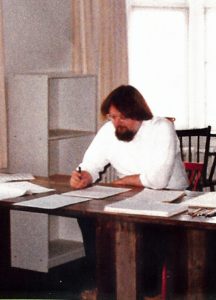
- How did you fulfill the role of city composer? Were you bound by the city? Or were you free about the nature and the extent of compositions?
“That’s complicated. I wrote music to the music school, for example, to the inauguration of the new buildings – 17 compositions, of which many were smaller, so there was a new composition in each room. I wrote a piano concert for an 11-year-old Romanian talent, Dana, as I also taught in the voice (½ hour duration). I wrote for inaugurations, anniversaries (Holstebro Gymnasium, 25 years, Children’s Seminar, 25 years, the opening of Jysk Open University, Jingles to the Radio, Works for the Music School Symphony Orchestra, a party event for the opening of the Music Theater (Ålborg Symf., Ole Schmidt), works for MGK foreigners tour, secondary school students in music, music for fernishes at the art museum, a work for Sognekirken (choir, orchestra, organ) – in other words music for everything. It was a mix of orders, own decisions and calls from the music school to organize music for this and that. For example, I wrote several choir / ensemble works for Holstebro Højskoles courses. I wrote a piece to the initiation of Frithioff Johansen’s major laser sculpture at TV-Midtvest’s (TV mid west) buildings: KAOSTEMPEL (Chaos Temple). The municipality of Holstebro did not interfere with what I wrote, it came abundantly without pressure.”
- Is there a particular of your works and / or projects that you want to emphasize from this period?
“There are 5: Barbaresco for 5 timpani, big tamtam / gong and grand piano – Amadé for piccoloflute, flute, g-flute, grand piano and 4 percussion players (5 Mozart portraits) – Metalsvinet (Metal swine), concert for piano and orchestra – KAOSTEMPEL (Chaos temple), electronic music with sound effects , grand piano, improvisations, etc. – China House in 3 versions: solo piano, whistle and piano, miniopera “Nightingale” for bass singer / ensemble.”
Two of the works mentioned are inspired by sculptures located in Holstebro – “Metalsvinet”, located on Brotorvet (Bridge Square) in a water pool surrounded by various small animals and with water running out of the mouth,
the pig is a copy from Florence of a bronze figure of Pietro Tacca from 1639
– and the “Kaos Tempel” by Frithioff Johansen,

– a 400 square meter iron sculpture from 1989, located on four 18 meter high columns as a laser sculpture (steel, concrete, laser light and white-light projection through holographic gratings), placed between Vandkraftsøen (the water power lake) and Folkeparken (the People’s Park).
In 1991, Willy was employed as Vejle Municipality’s new cultural chief. During the transitional period between Holstebro and Vejle, Willy reached his opus 63 – a work he wrote at the order of FUK (Folkekirkens Ungdomskor) as a common finishing work at the 1992 Landsstævne (nationwide competition) in Aarhus. The piece was called “Ridder Børsting” (Knight Børsting), and it was a cheerful and catchy ballad in old folk style.
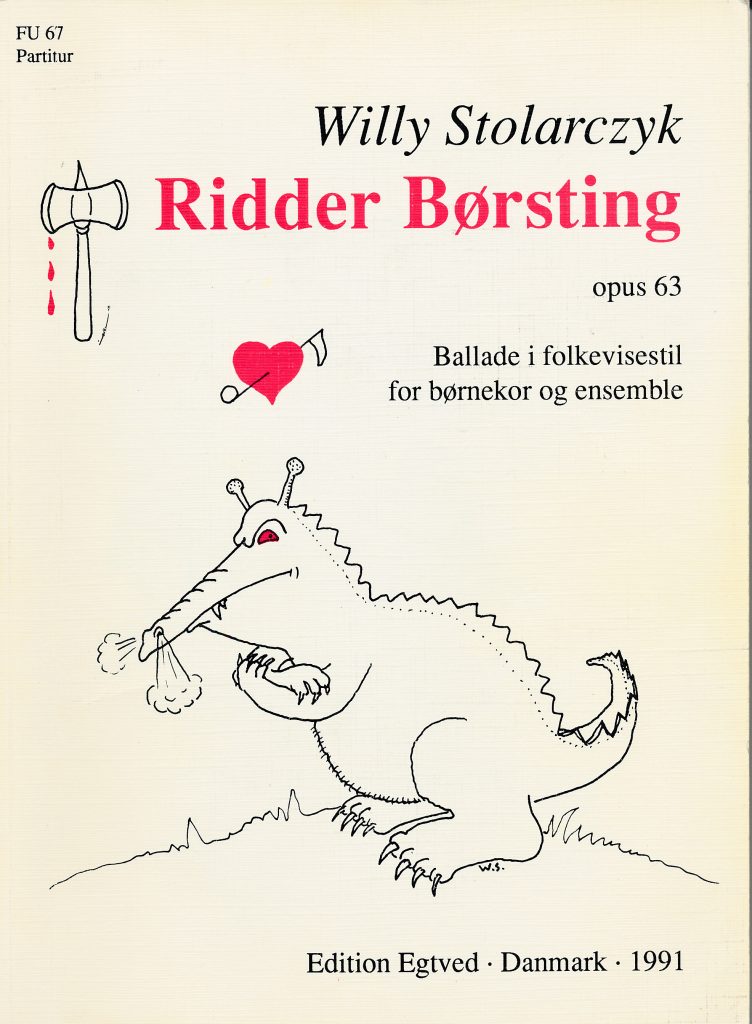
All the youth choirs from all over the country – over 1,500 people – formed a giant wide perimeter throughout the hall, and in the middle of it all was a podium with a professional ensemble and with Willy himself on the conductor podium. In order to keep track of all the choirs placed both in front, behind and at the sides of the conductor, no matter what way he turned, Willy had installed 5-color light regulation so that the different groups could be ready when their color shone.
As mentioned, Willy was enticed by a vacancy post as Culture Manager in Vejle. A former chairman of the municipality of Vejle tells in the celebration writing about the urban composer from Holstebro who had applied for the position and he continues: “The recruitment procedure was significantly different from what I previously – and certainly also since – have experienced as a member of the recruiting authority. As a matter of course, Lise participated in all recruitment rounds. No, not in the “recruitment room” but she follosed all the way to the door. She said goodbye, and then she went shopping. These were good days for the commercial life of the city.
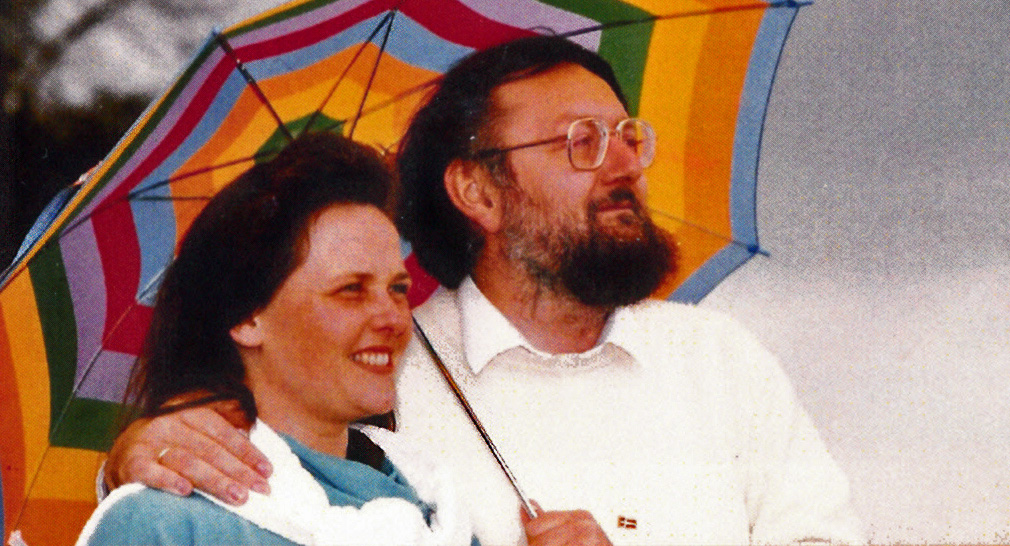
Although we, as a recruitment municipality, had done our efforts with the job posting, Willy introduced a detailed proposal / program on what he (and Lise) intended to add Vejle, and explained several times in such a convincing way that no one in the recruitment committee was in doubt that when we staffed Willy (there were no ifs) our city got the distinctive cultural personality we were looking for! Well, there was that little comment from a single member of the committee (the name is omitted): “Well, isn’t there too much Jumping Jack in Stolarczyk?” This remark was met by the city’s social committee chairman, with the following remark: “I would like to get such a Jumping Jack to the city, but in every Jumping Jack there is a string.” I don’t think we ever got a string in Willy, and thank you for that.”
- Are you a Jumping Jack?
“A Jumping Jack is a figure, often made of wood (a wooden man), who can only move when someone pulls the string. Such one I’m definitely NOT. It’s an expression that you often hear and I remember in TINTIN- The story “The journey to the moon”, how furious professor Tournesol becomes when he is named “Jumping Jack”. I’m not being furious, but it’s a kind of disparaging designation as far as I can see.”
Listen here to Willy’s distinguished interpretation of such one – the phrase “Sprællemanden” (Jumping Jack) from Carl Nielsen’s “Humoreske-bagateller” (Humoresque-bagatelles), opus 11:
Although Willy has big arm movements, his legs are firmly planted in the ground, and his visionary wealth of ideas has always been combined with a colossal overview and sense of reality. As former Mayor of Mayor Flemming Christensen puts it in the celebration magazine:
“As soon as Willy had been job interviewed and rolled out all his visions, the concerns were gone, also because he had an administrative background indicating that he could keep up on the small cultural budget.” And later in the lecture he writes: “Vejle had got an incredibly competent and diligent cultural personality with an unremitting energy and good ability to engage people crosswise, and moreover with the ability to attract sponsorship so that the economy could be stretched and a great beautiful mixed bouquet of events saw the light of the day.”
- Is there anything from your time as a cultural manager in Vejle, you will especially emphasize?
“Yes. The project with the 96 pianos at Koldinghus has an early story. As soon as I had been employed as a cultural manager in Vejle, Copenhagen announced its venture as Kulturby 96 (Culture City 96), with Trevor Davis as the leader. Since I was expected to develop Vejle’s cultural life, I decided to join K’96 immediately. I invited the culture leaders from Horsens, Fredericia and Kolding on a visit and presented them with the idea that the triangle area was linked to this great “express train”. At once they joined the idea and I immediately traveled to Copenhagen with our culture committee chairman to try to get Trevor Davis on our side. He was very positive and came to Vejle a few months later, and afterwards we met in my home where we over a glass of wine agreed on a schedule with the theme of Earth, Air, Fire and Water. For the next 3 years, we worked together to ensure that all 4 municipalities agreed and allocated $ 1 million each to a 1996 cultural festival. Copenhagen had promised to grant $ 5 million if we in common combined a similar amount. In that case, Vejle County also had to participate, and they did. The cultural development work was large and concentrated, but during the period 1 May to 31 August 1996 we carried out 100 major projects. All this 4-city plus county co-operation with a total of 300,000 people is undoubtedly – along with the composition and the performance of my symphony for 96 grand pianos, pianos and 4 percussionists, the most amazing ever in the triangular area’s cultural life.”
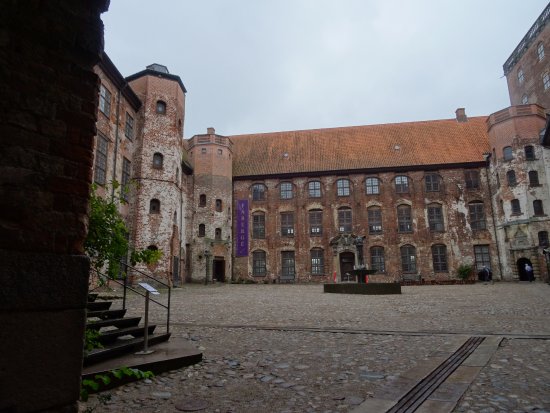
Willy Stolarczyk’s big work entitled “Earth-air-fire-water – Symphony of 96 grand pianos, pianos and percussion” was performed at Koldinghus, where 96 pianos and grand pianos were placed on all ledges in the newly renovated castle ruins. And as many of the country’s best pianists as well as 4 percussionists subsequently took their seats at the various levels of the castle and performed the work under the leadership of Spanish conductor José Ribera, pianist and professor at the Royal Danish Conservatory of Music in Copenhagen. A project of the kind is a logistic piece of art, for example Christian Juhl-Sørensen, chairman of the old honorary piano company Juhl-Sørensen, tells in the composer’s book about the project: “Although I’m “yes-saying” by nature, it nevertheless seemed surreal that I just had to: Provide 96 grand pianos – Get them transported to a ruin in Kolding – Get them tuned together – all with the aim of creating a qualitative foundation to make Willy’s composition Earth, Air, Fire & Water, realized the way Willy as a composer imagined.
The first step was to visit the old castle ruins of Koldinghus. Certainly, Koldinghus had been restored, but could it accommodate 96 pianos, and if they were to be placed on several floors, how was the capacity of the floor separators? It quickly became clear that the 2 top floors of the 4, where the grand pianos were to be placed, could not carry 48 grand pianos. It was therefore decided that 48 pianos should be placed on these floors. It made it easier for me that 96 grand pianos should not be obtained, as half would be replaced by pianos. ….. The next task was to make a plan for how the instruments would be tuned together in 440 hertz. For good reasons it could not happen after they were set up – in the same room. So it was decided that they were all tuned in 440 hertz in their respective locations before they were picked up and subsequently finely tuned after setup. From the sidelines I had followed Willy’s work on the completion of the huge score, which at the presentation filled the whole floor in a nearby sports hall. Miraculously everything was successful, and on the day of the performance, 96 pianists came flowing from the whole country to Kolding. Sympathies and antipathies from the Danish music environment were united here for the first and perhaps last time thanks to Willy’s ability to realize ideas, which for others would remain utopia. In my case, there was another task of transporting the instruments back to their right owners and getting them tuned again so that everything could appear as if nothing had happened – who would ever believe in such a story anyway? “
But it certainly is true – just you listen to Danica Records’s recording of the impressive performance of 1996:
In his book on the project in own release (2013), Willy writes about the performance of the score: “At that time I wrote everything in hand and copied it.” But what paper could contain 96 node systems? …. A giant work was drawing ahead!” After experimenting with more possibilities, Willy realized that the score for the conductor should be written on A-zero paper, which extensively corresponds to 16 A4 sheets. Then 100 of these A0 sheets were manufactured at Vejle Light Printing Company. You did not need 100 systems (96 pianists and 4 janits), because the different groups did not attend all the time but changed as in a symphony orchestra. In addition to the instruments, some pre-recorded natural sounds (rippling water, birdsong, thunderstorms, etc.) were included. And the management of these sounds demanded another professional musician who could read a score while the conductor was able to read the sounds of nature in his score. One might imagine the practical problems that emerged along the way, while the composer wrote his composition on the huge paper sheets. The creation process took 8 months.
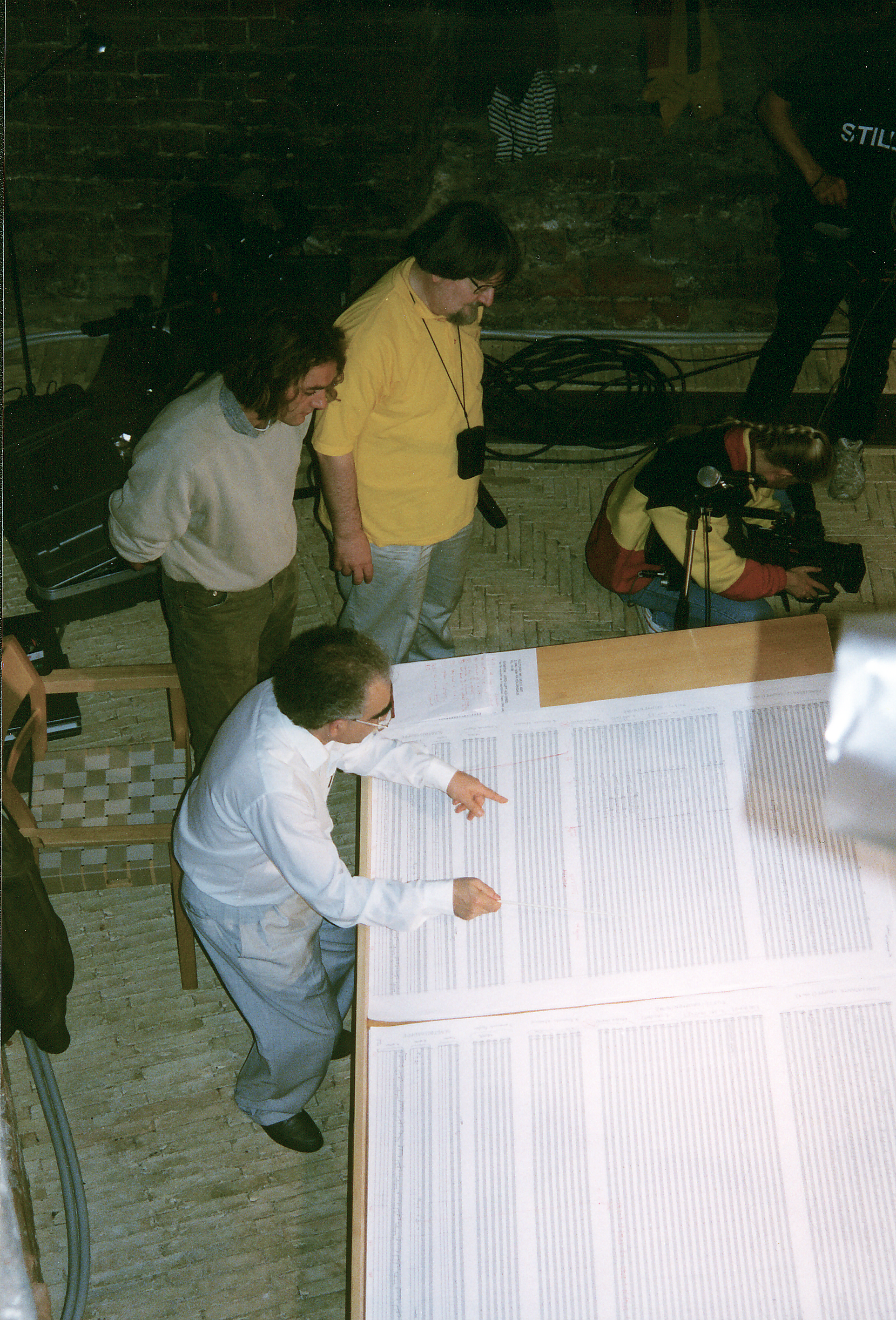
And then there was the printout for each of the 100 contributing musicians. In the composer association, a number of node printers were attached, which the members could use to print instrument voices from a score for the expense of the association. But when they in the composers’ association heard what this was all about, they probably became somewhat pale. It would cost them 200,000 kr. to print this particular piece – and that was more than the budget could bear. “We discussed the matter on the phone”, Willy explains in his projectbook, “and so I suggested that because the score was written in a fully legible handwriting, it would be possible instead to copy a whole additional score, then cut out each single musicians voice of this and then paste them onto plain A3 sheets (they could not stand up without tilting back and down behind the node frame). It would just be about making a few thousand sheets (!) and then distributing them to the musicians after copying all voices to make sure that no original voices were lost in the mail along the way! I asked my wife Lise, if she, as a musician, would be interested in doing this little work for me and the composer association if she received 20,000 kr. for the inconvenience. She took on the job (without making rubbish and without knowing what she had agreed to) and the president could wipe the sweat of the forehead and notify the office of the content of the new agreement. I will return to Lise’s little sparetime job later (she was not home-made housewife, but full-time musician and flute teacher). But in that way, Lise saved both the composers’ association and K’96 in Vejle County for a lot of trouble. Thanks to Lise, who did NOT know what she agreed to. Later, when she was sitting in clipping and note papers for the knees and our coffee pot had disappeared for days on the floor under the papers, and hundreds of glue sticks rose up, she began to get a suspicion. But then it was too late to whine.”
About her participation in the project, Lise Stolarczyk tells herself as follows in a post in the project book:
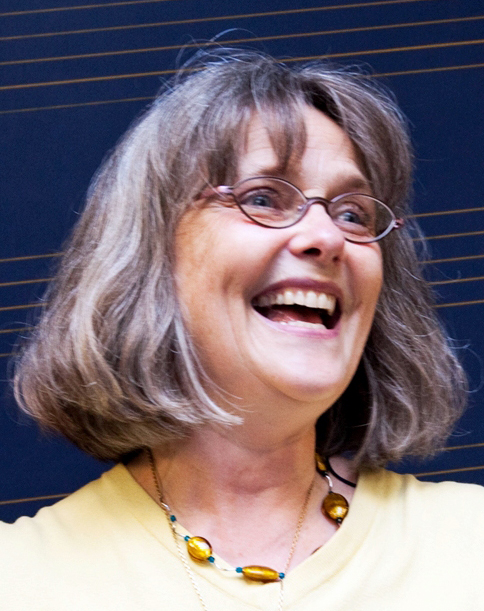
“When I think about that period in 1995/96, where I was heavily involved in the practical part of the project” Symphony “Earth, Air, Fire, Water” (Denmark’s biggest piano meeting), I have a feeling of having been in several James Bond movies and a couple of Formula One races. Everything ended up getting crazy fast.
For example, the day we had to hand over the score on The Royal Danish Conservatory of Music to Professor José Ribera. Willy was still in the process of having some corrections on the last pages, and they should subsequently be copied at Vejle Lystryk. When they were ready (just before the print shop closed) we should transport the entire score by car to Copenhagen – across the Great Belt – and remember – it was before the bridge had arrived so we had to reach a certain ferry. We had a completely fixed deadline, and it had to be adhered to, as the conductor had a very tight training plan to achieve it. When we picked up the last copies on Vejle Lystryk, we had very bad time to reach the ferry (I do not want to tell you how little), but we reached it, even though we almost flew on the ferry laid off from the dock!
When I had finished making all the voices ready, and when my special team of helpers to copy it all, pack it and send it to acting musicians, had finished the work, Willy would definitely out driving by car! It was not easy to settle down immediately. We therefore sat in our Mitsubishi Galant and drove in one stretch to Hannover, where for some reason Willy had deciced, on the same day, to see the great fountain in Herrnhäuser Schlosspark.
https://www.youtube.com/watch?v=9ruGm9xj4fo
We reached the destination (quite shortly after) and entered the park. The fountain ran only once an hour, so we sat down on a bench and waited. Immediately we fell asleep, leaning two each other, and we did not see the fountain. Then we walked around a bit, sat down again – but – fell asleep again and did not see the fountain this time either. Then we drove home. We still have not seen the fountain in operation … after nearly 17 years.“(From Willy’s projectbook 2013).
In addition to being married to Willy, Lise is also his closest working partner. Each having their independent careers, they also have the common “Duo FlautoPiano”, and it can not be counted how many concerts they have made together since they met at Holstebro Music School in 1978, where they both taught. “Our first appearance as a duo, I think, took place the day after we met!” Willy claims.
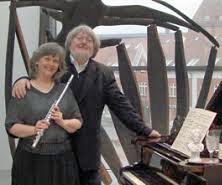
Lise is educated in Copenhagen at Verner Nicolet from the Royal Chapel and at the Santa Cecilia Conservatory in Rome at the world-famous whistle player Severino Gazzelloni. So it’s natural that Willy has written many works for the flute, most often dedicated to Lise, but also a flute concert to one of Lise’s former students, the flute virtuoso Janne Thomsen.
Listen to Willy’s “Ornithological Recitative and Toccata, Opus 8 – dedicated to Lise, who plays it on the flute accompanied by Willy:
The couple has performed in Paris, Vienna, Linz, Bratislava, Rome and Copenhagen, but also in the Netherlands – as some of the more prominent places. With their performances in Holland came an order to a composition from the flute soloist in the Concertgebouw Orchestra Emily Beynon a few years ago. And Willy’s finished composition – a 3-piece work for 17 flutists and 2 pianists – was performed in August 2017 in the Concertgebouw Chamber Music Hall in Amsterdam.
In addition to concert activities, Willy and Lise have been working together for 34 years to produce a musical adventure project about Hugo Ræv (Hugo Fox) and his friends. Up to the present day 5 CDs have been released, which alternate between reading and musical pieces for flute and piano. Many musical children and their parents love the stories and after each CD they have requested a continuation of the musically framed adventures.The musical working relationship between the couple means that music is always part of their lives – and the music is also in the luggage when they leave for free and travel on holiday. Eg. they have lived in Rome so many times, both in the caravan and at the Danish Institute of Science and Art, that their common time down there according to Willy is approx. 1.5 years.
- As far as I understand, there are two cities in particular, which you and Lise regularly visit and which you have a close relationship with – Rome and Vienna. I assume that the connection to Rome especially comes from the time when you studied composition, or …?
“Yes, but not only for that reason. Lise is educated at the Santa Cecilia Conservatory in Rome through a 4-year period. And – there was once in my conservatory time, where I really needed a change. I asked my teacher György Vasarhelyi what to do. “Have you ever been to Rome?” he answered. I did not. “Then go there as soon as possible,” he continued. When you get home, the depression has gone, crushed by the cultural shock you will experience. “It was close to Christmas and I managed to get a trip with Spies at 175 kr. for 14 days.

And Vasarhelyi was right. When I got home on December 22, loaded with Christmas presents, I was ready again. So, there are at least 3 reasons for reuniting Rome for both of us. But of course, my stay at Tage at the Danish Institute was of great importance.”
- How did you get so close to Vienna that the event manager in Vienna’s cultural administration refers to you as a Vienna expert and Vienna enthusiast – that you have composed a piece of music for the honor of Vienna – and that you celebrated your 60th birthday in the Austrian capital with family and Danish and Austrian friends?
“The first time I was in Vienna, I was only 17 years old. I traveled with a friend by train to Warsaw, on to Prague, Vienna, Salzburg and Munich. Great trip, but especially Vienna (Du Stadt) appealed to me.

It was midsummer and the atmosphere, the heat, the light, especially in the evening, had such a dreamlike character that I immediately decided I would return to this European center. It also had an influence that I already knew many of the major wiener composers’ works. In addition, I had read both Stefan Zweig and Franz Werfel and others. So the starting point was good.
Well, it was going to last long before I went to Vienna again. We came to know some Danish culture people in Vienna as well as a cellist in Vienna Philharmonic, Jørgen Fog and his Japanese wife, in addition, the head of the Danish Cultural Institute and his wife and the rest of the staff. Then there is a Danish pianist in Vienna, David Højer, who went to the soloist class in Aarhus when I was a teacher there. We were given the opportunity to hear 3 of the famous New Year’s concerts, and we discovered that in Vienna New Year’s Eve held a street party for 700,000 people! The first time was just after the fall of the wall, and on New Year’s Eve a large number of guests arrived from Hungary, the Czech Republic, Italy, etc. and the atmosphere was really high.
Especially when the clock struck twelve, the great bell of the Stephan’s Dome, Die Pummerin, began to hit his deep tones, which almost could only be heard with the feet, and suddenly the ears could hear Strauss’s “An der Schönen Blauen Donau” broadcast over large speakers while thousands of champagne bottles were pulled up and the champagne shower fell into the hair of the big crowds.”
Earlier in this article we asked the question: Has the key to succeeding in this highly ambitious plan been latent in Willy’s personality right from the start?
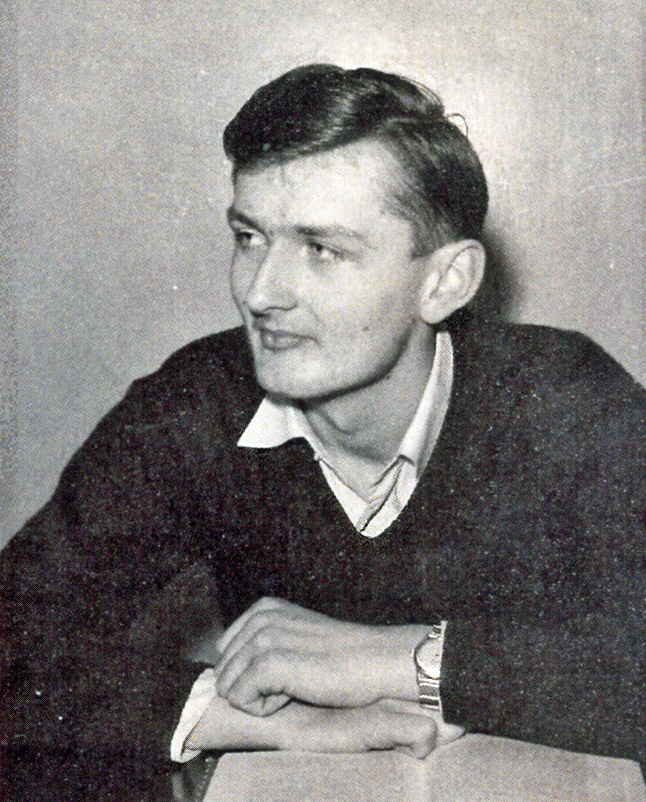
With all his life’s work up to now and especially with the creation and construction of the work “Earth, Air, Fire and Water”, Willy himself has given us the answer – as the former director of Vejle Music Theater Peter Sindberg so picturesque describes it in the party writing:
“In astrology, the 4 elements are described as follows:
Soil is to react calmly and be persistent.
Air is fast and lively and intellectualizes feelings and expectations.
Fire is spontaneous and impulsive with living imagination and wholehearted energy.
Water has a strong emphasis and sentivity.
Willy is all the 4 elements and it’s precisely these qualities that has made him the creative person that many have enjoyed during the many years.”

But although Willy today enjoys the role of grandfather and can spend his time as he wants, there is no evidence that he will retire provisionally. Admittedly, he no longer teaches (it would be if a grandson needs piano special treatment) and he is not employed by anyone.
But he composes, gives concerts, holds lectures and sometimes writes a book. Of compositions he has written the following works in recent years: “Never give a wolf big license!” (for the big organ and narrator) – “The Carl Nielsen Facebook” (for chamber choir a capella) – and finally: “The Spirit of Music and the Great Anniversary” for Holstebro Music School for their 50th anniversary on March 17th 2018. There are over 100 contributors, and Willy will conduct the work himself.
- With such a large event, something that couldn’t have been anticipated might easily happen? Could it stress you thinking something could go wrong?
“It’s about not losing the sense of the joke and the unexpected when composing. For example, one of the musicians from our anniversary orchestra phoned me yesterday and told worrying that a group of music school students who should participate in the anniversary piece with a part of the music they composed themselves (and which I was not allowed to know beforehand) had completely abandoned participating for unknown reasons. What should we do?
We must take it easy, I replied, and take note of their canceled cooperation. I’ll figure something out.
Then at the same moment it struck me what I would do when we came to the moment when we should have heard their homemade part: I will turn to the audience and tell them that the student group has not reached so far that they dare to act publicly. BUT – instead they want to play it in a laundry basement nearby. I will then devote one minute, as I claim that the piece takes, and in that time – and in almost complete silence, together with the audience – imagine the music each in our own way. Once the minute has passed (it must be measured with a metronome), the performance is over and the audience may like to applause! Thus – I hope – the cheerfully will replace the embarrassing, and – WOW – the situation is not only saved but possibly improved and replaced by a “composition” that will recall John Cage’s famous happening “4:33” from 1953 . Only my invention must be called Unhearable!“

